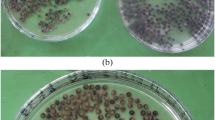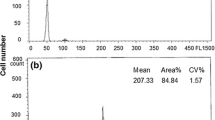Summary
Nine induced tetraploid females were artificially inseminated by UV-irradiated sperm collected from diploid males, in order to induce the gynogenetic development of their ova. Most of the resulting embryos were diploid (or minor aneuploids). Several gynogenetic tetraploids, likely to issue from unreduced ova, were also detected in these progenies. The same females fertilized by normal sperm of diploid males gave a majority of triploids and several pentaploids, while the fertilization by normal sperm of tetraploid males gave rise to a majority of tetraploids and one hexaploid. The same crosses, after the eggs had been heat-shocked to double the maternal genetic contribution, yielded about three-quarters pentaploids and one quarter haploids (normal sperm of diploids), or three-quarters hexaploids and one quarter diploids (normal sperm of tetraploids). These haploids and diploids are likely to result from androgenesis.
Similar content being viewed by others
References
Allendorf FW, Seeb JE, Knudsen KL, Thorgaard GH, Leary RF (1986) Gene-centromere mapping of 25 loci in rainbow trout. J Hered 77:307–312
Beetschen JC (1962) Sur la descendance de femelles tetraploides croisées avec des mâles diploides, chez l'amphibien urodèle, Pleurodeles waltlii. CR Acad Sci, Ser D 255:3068–3070
Bidwell CA, Chrisman CL, Libey GS (1985) Polyploidy induced by heat shock in channel catfish. Aquaculture 51:25–32
Bingham ET (1980) Maximizing heterozygosity in autopolyploids. In: Lewis WH (ed) Polyploidy, biological relevance, part IV. Plenum Press, New York, pp 471–490
Chourrout D (1984) Pressure-induced retention of second polar body and suppression of first cleavage in rainbow trout: production of all-triploids, all-tetraploids, heterozygous and homozygous diploid gynogenetics. Aquaculture 36:111–126
Chourrout D (1986) Techniques of chromosome manipulation in rainbow trout: a new evaluation with karyology. Theor Appl Genet 72:627–632
Chourrout D, Happe A (1986) Improved methods of chromosome preparation in rainbow trout, Salmo gairdneri. Aquaculture 52:255–261
Chourrout D, Chevassus B, Krieg F, Happe A, Burger G, Renard P (1986) Production of second generation triploid and tetraploid rainbow trout by mating tetraploid males and diploid females. Theor Appl Genet 72:193–206
Dawson GWP (1962) An introduction to the cytogenetics of polyploids. Blackwell, Oxford
Dewey DR (1980) Some applications and misapplications of induced polyploidy to plant breeding. In: Lewis WH (ed) Polyploidy, biological relevance, part IV. Plenun Press, New York, pp 445–470
Diter A, Guyomard R, Chourrout D (1987) Gene segregation in induced tetraploid rainbow trout (Salmo gairdneri Richardson): genetic evidence of preferential pairing of homologous chromosomes. Genome (submitted)
Ellerström S, Sjödin J (1974) Studies on the use of induced autopolyploidy in the breeding of red clover. 3. Frequency and behavior of aneuploids in a tetraploid clover Ley. Z Pflanzenzücht 71:253–263
Fankhauser G, Humphrey RR (1950) Chromosome number and development of progeny of triploid axolotl females mated with diploid males. J Exp Zool 115:207–249
Fankhauser G, Humphrey RR (1959) The origin of spontaneous heteroploids in the progeny of diploid, triploid and tetraploid axolotl females. J Exp Zool 142:379–422
Guyomard R (1984) High level of residual heterozygosity in gynogenetic rainbow trout, Salmo gairdneri Richardson. Theor Appl Genet 67:307–316
Humphrey RR, Fankhauser G (1949) Three generations of polyploids in ambystomid salamanders. J Hered 40:7–12
Kihara H (1951) Triploid watermelons. Proc Am Soc Sci 58:217–230
Myers JM (1985) Tetraploid induction in Oreochromis species. In: 2nd Int Symp Genet Aquacult, Davis Calif (Abstr)
Nishioka M, Ueda H (1983) Studies on polyploidy in Japanese treefrogs. Sci Rep Lab Amphib Biol Hiroshima Univ 6:207–252
Parsons JE, Thorgaard GH (1985) Production of androgenetic diploid rainbow trout. J Hered 76:177–181
Sakharov VV, Kuvarin VV (1970) Aneuploidy in tetraploid rye. Genetika 6:17–22
Thompson D, Scott AP (1984) An analysis of recombination data in gynogenetic diploid rainbow trout. Heredity 53:411–452
Thorgaard GH, Gall GAE (1979) Adult triploids in a rainhow trout family. Genetics 93:961–973
Thorgaard GH, Allendorf FW, Knudsen KL (1983) Gene-centromere mapping in rainbow trout: high interference over long map distances. Genetics 103:771–783
Author information
Authors and Affiliations
Additional information
Communicated by R. Riley
Rights and permissions
About this article
Cite this article
Chourrout, D., Nakayama, I. Chromosome studies of progenies of tetraploid female rainbow trout. Theoret. Appl. Genetics 74, 687–692 (1987). https://doi.org/10.1007/BF00247542
Received:
Accepted:
Issue Date:
DOI: https://doi.org/10.1007/BF00247542




